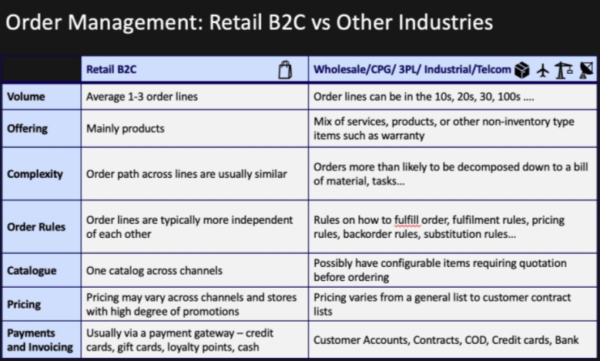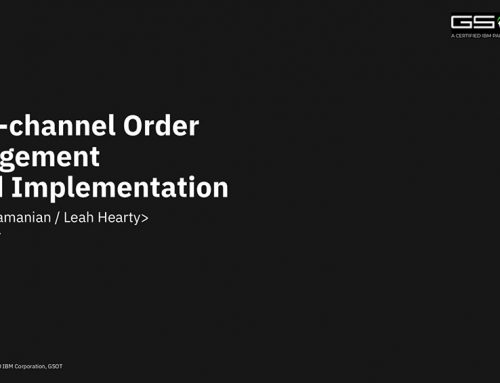Do Order Management Systems Have Applications Outside of Direct-To-Consumer?
Retail Order Management systems can also support B2B helping you make the most of your investment in OMS
The past 20 years has seen an explosion in the adoption of customer order management systems, helping retailers bring their web, store, social and mobile channels together to offer a single, consistent omnichannel experience for their consumers, as they transform their organisations into truly digital businesses. These OMS platforms consolidate a single view of “inventory availability” across warehouses, stores, suppliers and manufacturers including material that is in-transit to maximise the options to meet a customer promise. These systems act as a central hub for all customer order activity and deal with the complex order orchestration across the entire supply chain and ecosystem of trading partners. Then of course they power the entire process in reverse to provide a strong returns/exchanges flow and end-to-end visibility of the entire customer order lifecycle.
We are starting to now see organisations looking to leverage that same investment in OMS (already managing their direct-to-consumer inventory, orders and shipments) to provide similar capabilities in their B2B supply chain.
Enterprise class Order Management Systems are capable of this flexibility because the core foundation on which platforms such as IBM Sterling OMS were built, was to address complex B2B business models that were the driver for the creation of OMS in the first place – well ahead of the .com boom that powered the birth of the B2C order management market.
Let’s compare the profile of classic retail B2C orders with wholesale and other order types from other industries:

There are some obvious differences. In the world of retail store replenishment the supply chain is pushing inventory from DC/Hubs to smaller locations against a plan, this is in contrast to the pull nature of replenishment for customer demand eg shipping from a DC for a collection in store for an online order. An efficient fulfilment supply chain needs to manage the stock across different types of location, find the best option to meet demand and then combine the chosen product items with additional services where appropriate. In the Telco industry that could mean provisioning of services, within the industrial sector it could be installation or kitting. The engine dealing with these demands also needs to cope with different tiered customer/supplier price lists, promotions and payment methods. A flexible, adaptable OMS delivering B2C capability can deal with all these areas within the same platform.
Let’s consider some examples
F&F are an $800m Korean-based retail group that operate under 4 main brands across multiple SE Asian regions. They approached GSOT for assistance with their OMS rollout after hearing about some of our other project successes in the local region.
Prior to implementation of Sterling OMS, F&F subsidiaries (or branches) placed orders for a new retail season manually, through a process that involved a huge product catalogue that was shared via a Microsoft Excel spreadsheet, with wholesale orders captured offline in a spreadsheet without any visibility of available supply. Stock could be available in central DCs while other products required manufacture by F&F or via relationships with OEM suppliers.
GSOT implemented Sterling OMS to automate this process. Supporting multiple catalogs and a stock pool segmented by region, brand and channel but able to flex when required. Now wholesale buyers can view the new season catalog online and place orders against a view of supply. We automated the process for placement of purchase orders on OEM suppliers and provided complete visibility across the fulfilment process from production through to fulfilment.

A fantastic example of a B2B2C model – GSOT worked with a high-end jeans and denim manufacturer and wholesaler helping them deliver a consistent scalable omni-channel service in order to sell their denim products globally direct to consumer alongside their wholesale operation.
Over a 9-month period we implemented OMS to enable processes such as click and collect, ship from store and global call centre. We used the platform to support distribution and picking processes in the warehouse for wholesale and a B2BC selling model that they operate with franchise store partners around the world. Delivered on time and on budget but leveraging the OMS functionality in new innovative ways to extend traditional B2C capabilities.

We see this combination of B2C and B2B being most attractive to Global brands traditionally who operate in wholesale but are looking to get closer to their consumers and sell direct particularly in areas such as footwear, apparel, jewellery and CPG.
In summary there is a huge opportunity to use agile Order Management Systems that already deliver flexible omnichannel capability for retailers across other industries and in B2B scenarios – the building blocks are the same. Looking for the right solution and experienced implementation partner to deliver? Give GSOT a call.






Leave A Comment